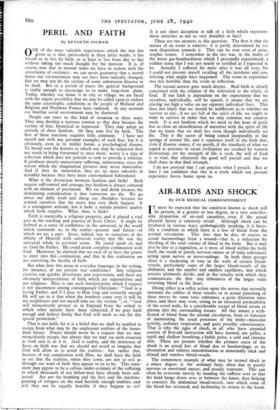AIR-RAIDS AND SHOCK
By OUR MEDICAL CORRESPONDENT
IT must be expected that the condition known as shock will be present, in a greater or less degree, in a very consider- able proportion of air-raid casualties, even if the actual physical injury is relatively trivial. Although shock can be produced in various ways, pathologically speaking, it is basic- ally a condition in which there is a loss of blood from the normal circulation. This loss may be due, of course, to actual haemorrhage from a wound—that is, a reduction by bleeding of the total volume of blood in the body. But it may also be due to a stagnation, as it were, of blood within the body itself, the result of purely nervous causes or of toxic substances acting upon nerves or nerve-endings. In both these groups there is a slackening of tone in the walls of certain blood- vessels, particularly some of the larger blood-vessels of the abdomen, and the smaller and smallest capillaries, into which arteries ultimately divide, and in the venules with which they communicate, the first tiny tributaries of the larger veins returning blood to the heart.
Owing either to a reflex action upon the nerves that normally maintain the calibre of these vessels, or to actual poisoning of these nerves by some toxic substance, a great dilatation takes place, and there may even, owing to an increased permeability of the vessel walls, be a considerable escape of blood serum or plasma into the surrounding tissues. All this means a with- drawal of blood from the normal circulation, from its function of maintaining the usual processes of- the body—muscular activity, ordinary respiration, and quite possibly consciousness. That is why the signs of shock, as all who have attended courses of first-aid instruction will have learned, are pallor, a rapid and shallow breathing, a feeble pulse, a cold and clammy skin. These are present whether the primary cause of the shock is an actual loss of blood due to haemorrhage, or its absorption and relative immobilisation in abnormally slack and dilated and toneless blood-vessels.
The commonest example of what may be termed shock in a minor degree is the ordinary faint, often due to purely nervous or emotional causes, and usually transient. This can often be overcome merely by bending the sufferer over so that the head hangs down over or between the knees, thus helping to constrict the abdominal blood-vessels, into which some of the blood has retreated, and facilitating its return to the brain.
But the one essential treatment of shock—after checking actual haemorrhage if this is present—is warmth. Every first-aid post should therefore be kept warm—a temperature of 70 degrees is not too high—and be provided with hot-water bottles and blankets. These latter should also be ready to hand in all private houses where the occupants or others may be taking shelter. Warm drinks should also be available, especially in cases of haemorrhage, where there has been much loss of blood from the body, and provided it is reasonably certain that internal bleeding is not going on. Such further measures as blood transfusion or the transfusion or injection of other fluids are matters for the medical expert ; and this is also the case in respect of certain drugs, such as adrenalin and pituitrin, that, in some kinds and at certain stages of shock, may be valuable. But for the minor degrees of shock, mainly due to fear, emotion, or an exaggerated reaction to pain, the cheerfulness and self-command of those in charge or attendance at a scene of emergency is an additional, and by no means the least important, form of antidote. -



























 Previous page
Previous page